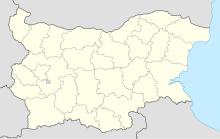| Location | |
|---|---|
| Location | Chelopech |
| Sofia Province | |
| Country | Bulgaria |
| Production | |
| Products | Gold |
| Owner | |
| Company | Dundee Precious Metals, Dundee Corporation |
| Website | https://www.dundeeprecious.com/ |
The Chelopech mine is one of the largest gold mines in Bulgaria. [1] The mine is located at the western part of the country in Sofia Province. [1] The mine has estimated reserves of 41 tons of gold and 4,182 tons of silver. [1]
